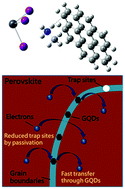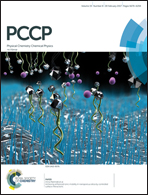Graphene quantum dot incorporated perovskite films: passivating grain boundaries and facilitating electron extraction†
Abstract
Organic–inorganic halide perovskites have emerged as attractive materials for use in photovoltaic cells. Owing to the existence of dangling bonds at the grain boundaries between perovskite crystals, minimizing the charge recombination at the surface or grain boundaries by passivating these trap states has been identified to be one of the most important strategies for further optimization of device performance. Previous reports have mainly focused on surface passivation by inserting special materials such as graphene or fullerene between the electron transfer layer and the perovskite film. Here, we report an enhanced efficiency of mesoscopic perovskite solar cells by using graphene quantum dots (GQDs) to passivate the grain boundaries of CH3NH3PbI3. The highest efficiency (17.62%) is achieved via decoration with 7% GQDs, which is an 8.2% enhancement with respect to a pure perovskite based device. Various analyses including electrochemical impedance spectroscopy, time-resolved photoluminescence decay and open-circuit voltage decay measurements are employed in investigating the mechanism behind the improvement in device performance. The findings reveal two important roles played by GQDs in promoting the performance of perovskite solar cells – that GQDs are conducive to facilitating electron extraction and can effectively passivate the electron traps at the perovskite grain boundaries.



 Please wait while we load your content...
Please wait while we load your content...